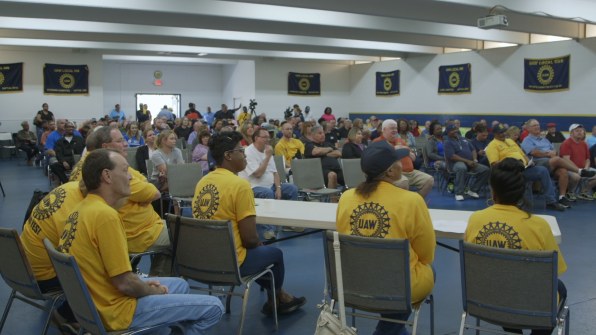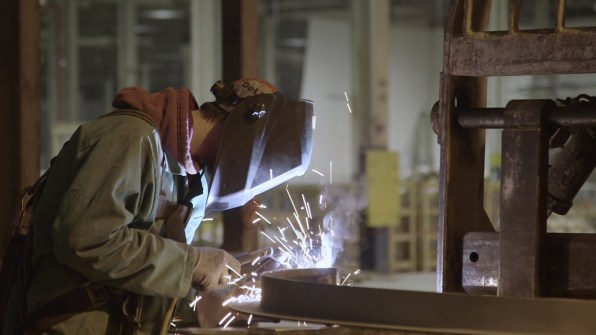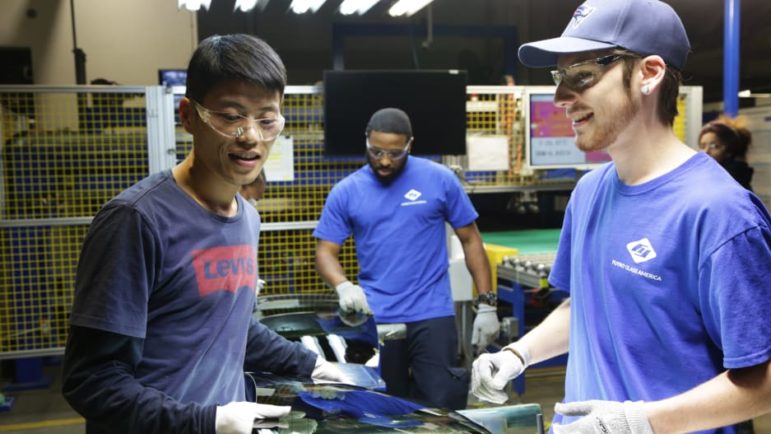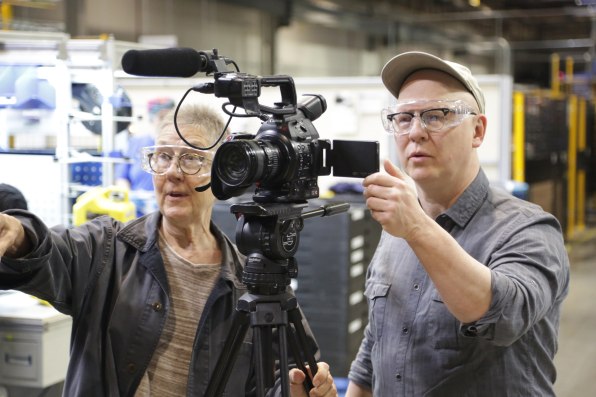
[Photo: courtesy of Netflix]

Share
American Factory a complex tale of class struggle on shifting global terrain; reducing the story to culture clash overlooks the real threat of global corporatism
Julia Reichert and Steven Bognar’s recent film American Factory is a sensitive, compelling look inside Fuyao Glass America, a Chinese automotive glass manufacturer that took over a former General Motors plant in their hometown of Dayton, Ohio. The film follows workers and management through the plant’s opening days and into a failed union drive.
Multiple reviewers attribute the central conflict to the company’s Chinese roots, an “East vs. West conflict.” But rather than simply “cultural differences” or “incompatibility,” American Factory depicts the shifting ground of globalization, and workers’ attempts to find stability therein – across national, cultural, and racial lines.
Rolling Stone calls it “a testament to the immutable characters of two national identities.” A review on rogerebert.com says “the trouble is that there are innate differences between the Chinese and American attitudes toward work that simply cannot be overlooked.”
Reading these reviews feels troublingly familiar as an Asian American. They default to lazy cultural essentialism – that is, the Chinese treat their workers bad because they’re Chinese – rather than because of the realities of global capitalism. Such statements imply that the “American” position is the worker-friendly one, as though America weren’t one of the least
Is it fair to call it a “cultural difference” when accounting for differences in labor standards between countries, shaped by vastly different histories? Is it an “East vs. West” divide when workers on both sides of the Pacific are going on strike for improved conditions? And, perhaps most crucially, when U.S. and Chinese corporations both operate overseas in a multinational race to the bottom?
To be sure, interpersonal tensions along cultural and national lines play out at Fuyao Glass America. A white American worker complains about feeling like she is “in China” when she walks into work; another, also white, says that “this is America, we don’t need Chinese children singing and praying” on flatscreen TVs in the break room. Fuyao management gives a series of grossly generic, sometimes cringe-worthy talks to its Chinese workers about American culture; president Jeff Liu at one point tells Chinese workers of their American counterparts, “We need to use our wisdom to guide and help them. Because we’re better than them.”
But the context for these tensions is that Fuyao is a multinational corporation operating an overseas plant and trying to put down a union effort. It appears to be the site of multiple safety violations and pays its employees significantly lower wages than its predecessor. Workers at General Motors had a union contract and carry expectations shaped by that experience. One worker, Shawnea, reveals that she made over $29/hour at General Motors with a UAW contract; at Fuyao, she makes $12.68. The safety supervisor, Robert, notes with concern that people are being exposed to dangerous levels of heat inside the factory. Bobby, a veteran autoworker, has his first workplace injury at Fuyao.

That’s a ubiquitous story about work in 21st century America. It calls to mind the local example of Lakeville Motor Express, a Minnesota trucking company that shut down overnight and opened up shop under a different name and no union contract. And without a union, workers face increased risk of injury, even death. While General Motors and Fuyao are separate corporations, Fuyao is part of GM’s supply chain. In other words, GM closed their plant and one of their parts suppliers moved in, with no union contract.
Inside Fuyao Glass America, as employees begin to organize and management pushes back, it’s sometimes unclear what is national and what is class conflict. The talks by Fuyao management could be seen as simplistic outsider attempts to educate their workers about “American culture,” but in the context of a union drive, become more insidious management techniques to divide the Chinese nationals from their American counterparts and thereby dissuade them from joining the union.
Reichert and Bognar meld sound bites of worker complaints about “the Chinese,” with complaints about workplace safety, pay, and basic respect. It’s not clear if the workers mean “all Chinese,” or “management.” We also get to hear considerably less from rank-and-file Chinese workers than their American counterparts and from Fuyao management. Though we spend a lot of time with Wong, a furnace engineer, his struggles coming to the US, and his heartwarming relationship with Rob, an American coworker, we don’t hear a lot of Wong’s take on workplace politics. In the filmmakers’ defense, it’s hard to know whether this is due to oversight on their part or to the kind of pressures Chinese workers in the US might be under. We don’t hear anything about their visas, if they hope to stay in the US, or how their immigration status might impact their ability to be vocal about certain issues.

Whatever the reason might be, we don’t get to find out whether many Chinese workers buy
While Reichert and Bognar secured impressive access to every level of Fuyao’s operation, it’s difficult to blame the filmmakers for some of the movie’s unanswered questions. If nothing else, they do a very adequate job showing the conditions that might prevent some actors from saying more.

Rather than being a “fascinating tragicomedy about the incompatibility of American and Chinese industries” (Indiewire) the film and the facts suggest that the interests of global capital are all too aligned. They’re just not working for working class people – anywhere.
Fuyao’s management techniques come straight out of the anti-union playbook used by American companies; they hire LRI, an American professional union-busting firm. Fuyao Glass America has been making a profit since 2018, and supplies glass for the same General Motors who closed up shop and left all those folks jobless in 2008. General Motors is alive and well, operating plants in 37 countries and paying workers much lower wages than they would have to at home. In fact, General Motors now employs more workers in China that it does UAW members in the US.
Chalking the harms of global capitalism up to cultural differences does a disservice to the workers who are fighting for dignity on both sides of the Pacific. Bognar and Reichert leave us with a few of those workers: Rob and Wong, the furnace engineers whose unlikely friendship is one of the scarce uplifting points in the movie; Timi, a union activist, will “never give up on the American dream.” In a system that values them only as labor, these workers retain their humanity and their complexity. It’s the only thing that sets them aside from their robot competitors, which the filmmakers invoke in the movie’s sobering final scenes.
The ability to set differences aside and support each other may be the only solution to increased globalization and automation, in which a handful of corporations laugh all the way to the bank while the rest of us fight over a shrinking pool of jobs.

